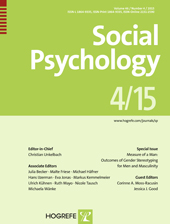Masculine Identity, Ambivalent Sexism, and Attitudes Toward Gender Subtypes
Favoring Masculine Men and Feminine Women
Abstract
Abstract. We investigated how men’s masculine identification and ambivalent sexism relate to evaluations of male and female subtypes. Masculine identification correlated with positive attitudes toward male and female types that conform to traditional gender norms (i.e., masculine men, feminine women), but negative attitudes toward feminine men. However, masculine identification was not associated with negative evaluations toward other nontraditional male (stay-at-home fathers, feminist men) or with nontraditional female (masculine women, career women, and feminist women) subtypes. By contrast, hostile sexism consistently predicted negative evaluations of nontraditional female and male types, whereas benevolent sexism predicted positive evaluations of traditional female types. We suggest that masculine identification generally promotes favoritism toward traditional male and (like benevolent sexism) traditional female subtypes, rather than (as hostile sexism does) derogation toward nontraditional subtypes.
References
(2004). An organizing framework for collective identity: Articulation and significance of multi-dimensionality. Psychological Bulletin, 130, 80–114. doi: 10.1037/0033-2909.130.1.80
(1974). The measurement of psychological androgyny. Journal of Consulting and Clinical Psychology, 42, 155–162. doi: 10.1037/h0036215
(2013). Gender dichotomization at the level of ingroup identity: What it is, and why men use it more than women. Journal of Personality and Social Psychology, 105, 425–442. doi: 10.1037/a0033126
(2011). Precarious manhood and its links to action and aggression. Current Directions in Psychological Science, 20, 82–86. doi: 10.1177/0963721411402669
(1999). The psychology of prejudice: Ingroup love or outgroup hate? Journal of Social Issues, 55, 429–444. doi: 10.1111/0022-4537.00126
(2011). Amazon’s Mechanical Turk: A new source of inexpensive, but high quality data? Perspectives on Psychological Science, 6, 3–5. doi: 10.1177/1745691610393980
(1998). Subtypes of women and men: A new taxonomy and an exploratory categorical analysis. Journal of Social Behavior and Personality, 13, 679–696.
(2005). Hegemonic masculinity: Rethinking the concept. Gender and Society, 19, 829–859. doi: 10.1177/0891243205278639
(2004). Correlates of negative attitudes toward gay men: Sexism, male role norms, and male sexuality. Journal of Sex Research, 41, 259–266. doi: 10.1080/00224490409552233
(1985). Level of categorization and the content of stereotypes. Social Cognition, 3, 145–167. doi: 10.1521/soco.1985.3.2.145
(2000). Stereotypes as dynamic constructs: Women and men of the past, present, and future. Personality and Social Psychology Bulletin, 26, 1171–1188. doi: 10.1177/0146167200262001
(2004).
Aversive racism . In M. P. ZannaEd.. Advances in experimental social psychology (Vol. 36, pp. 1–51). San Diego, CA: Academic Press.(1987). Sex differences in social behavior: A social-role interpretation. Hillsdale, NJ: Erlbaum.
(1989). Gender stereotypes and attitudes toward women and men. Personality and Social Psychology Bulletin, 15, 543–558. doi: 10.1177/0146167289154008
(1999). The origins of sex differences in human behavior. American Psychologist, 54, 408–423. doi: 10.1037/0003-066X.54.6.408
(1997). The two faces of adam: Ambivalent sexism and polarized attitudes toward women. Personality and Social Psychology Bulletin, 23, 1323–1334. doi: 10.1177/01461672972312009
(1996). The Ambivalent Sexism Inventory: Differentiating hostile and benevolent sexism. Journal of Personality and Social Psychology, 70, 491–512. doi: 10.1037/0022-3514.70.3.491
(2001).
Ambivalent sexism . In M. P. ZannaEd., Advances in experimental social psychology (Vol. 33 pp. 115–188). Thousand Oaks, CA: Academic Press.(2000). Beyond prejudice as simple antipathy: Hostile and benevolent sexism across cultures. Journal of Personality and Social Psychology, 79, 763–775. doi: 10.1037/0022-3514.79.5.763
(2004). Bad but bold: Ambivalent attitudes toward men predict gender inequality in 16 nations. Journal of Personality and Social Psychology, 86, 713–728. doi: 10.1037/0022-3514.86.5.713
(2005). The structure of gender type perception: Testing the elaboration, encapsulation, and evaluation framework. Social Cognition, 23, 429–464. doi: 10.1521/soco.2005.23.5.429
(2003). Explaining heterosexual men’s attitudes toward women and gay men: The theory of exclusive masculine identity. Psychology of Men and Masculinity, 41, 37–56. doi: 10.1037/1524-9220.4.1.37
(1992). A collective self-esteem scale: Self-evaluation of one’s social identity. Personality and Social Psychology Bulletin, 18, 302–318. doi: 10.1177/0146167292183006
(2003). Sexual harassment under social identity threat: The computer harassment paradigm. Journal of Personality and Social Psychology, 85, 853–870. doi: 10.1037/0022-3514.85.5.853
(1988). The “black sheep effect”: Extremity of judgements toward ingroup members as a function of group identification. European Journal of Social Psychology, 18, 1–16. doi: 10.1002/ejsp.2420180102
(2012). Conducting behavioral research on Amazon’s Mechanical Turk. Behavior Research Methods, 44, 1–23.
(2010). Running experiments on Amazon Mechanical Turk. Judgment and Decision-Making, 5, 411–419.
(2007). The F word: Is feminism incompatible with beauty and romance? Psychology of Women Quarterly, 31, 125–136. doi: 10.1111/j.1471-6402.2007.00346.x
(2000). Instrumental and expressive traits, trait stereotypes, and sexist attitudes: What do they signify? Psychology of Women Quarterly, 24, 44–62. doi: 10.1111/j.1471-6402.2000.tb01021.x
(1981). Social identity and intergroup relations. London, UK: Cambridge University Press.
(1992). Men and masculinities: Scales for masculinity ideology and masculinity-related constructs. Sex Roles, 27, 573–607. doi: 10.1007/BF02651094
(1986). The structure of male role norms. American Behavioral Scientist, 29, 531–543. doi: 10.1177/000276486029005003
(2013). Hard won and easily lost: A review and synthesis of theory and research of precarious manhood. Psychology of Men & Masculinity, 14, 101–113. doi: 10.1037/a0029826
(2008). Precarious manhood. Journal of Personality and Social Psychology, 95, 1325–1339. doi: 10.1037/a0012453
(2006). Ten years of psychological research on men and masculinity in the United States: Dominant methodological trends. Sex Roles, 55, 649–658. doi: 10.1007/s11199-006-9120-1



